20 photos of shipwrecks from WWI and WWII
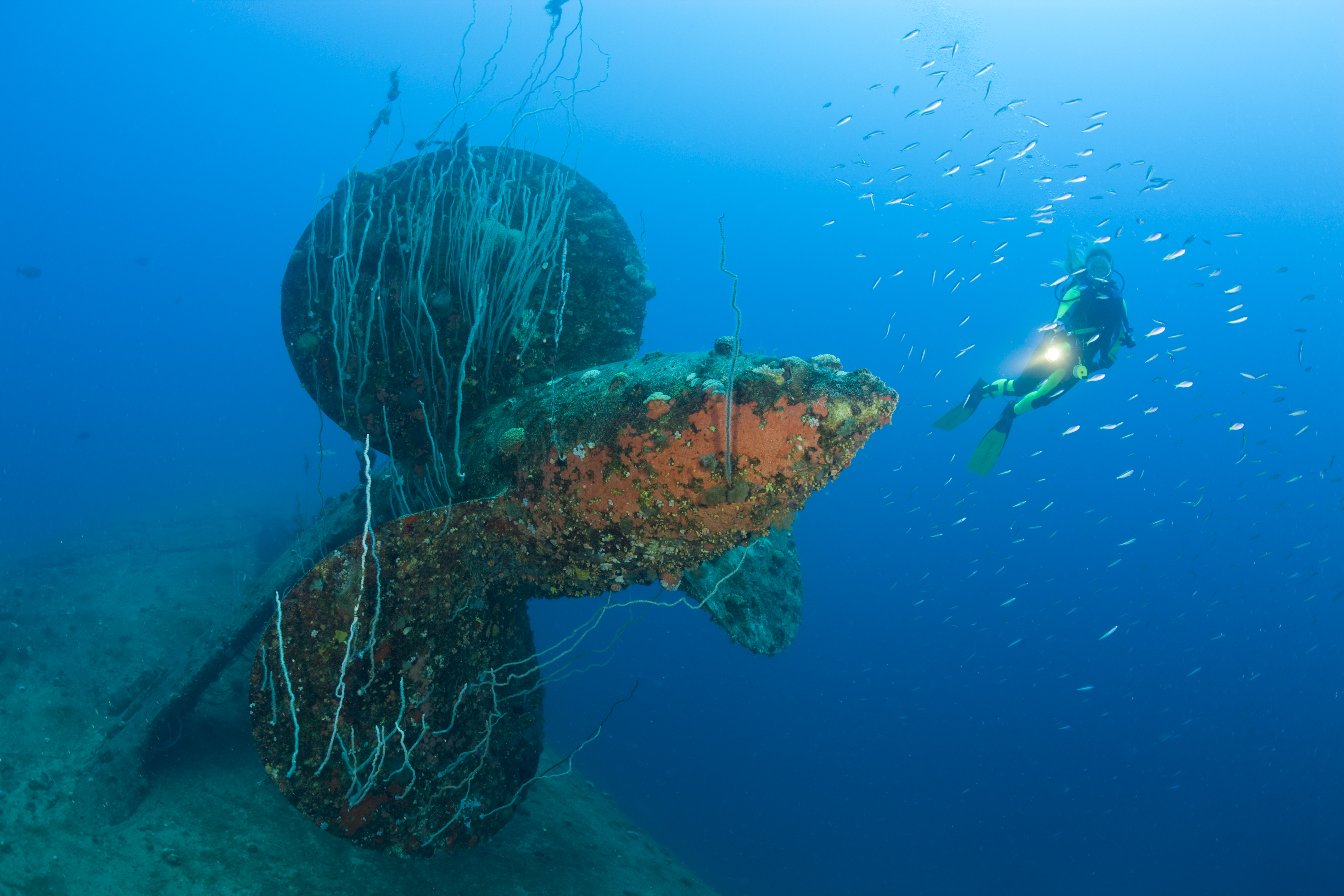
Reinhard Dirscherl/ullstein bild via Getty Images
20 photos of shipwrecks from WWI and WWII
A diver circles the propeller of HIJMS Nagato Battleship
Beneath the vast surface of the world’s oceans lie an estimated 3 million shipwrecks, of which just an estimated 1% have been explored. From “Robinson Crusoe” to the “Pirates of the Caribbean,” shipwrecks have permeated popular culture via books and films and been a source of morbid fascination for generations. Indeed, with the resurgent popularity of sea shanties in 2021 and the 25th-anniversary rerelease of the Oscar-winning modern classic “Titanic” in 2022, interest in the history that rests upon the ocean floor seems, once more, to be permeating the cultural zeitgeist.
During the first half of the 20th century, World War I and World War II were periods of uniquely heavy naval engagement. The rise of submarine warfare in WWI changed the way naval warfare was waged, the effect of which radiated into the more technologically developed vessels employed in WWII. That conflict alone resulted in at least 15,000 ships sunk, a number that is likely to rise as more wreckage is discovered over time.
How negative an impact this wreckage has on marine life is still being studied. For the most part, these sunken ships are often extremely well preserved, having been in the water now only around 100 years. Some are even easily accessible to tourists via scuba diving or even snorkeling, providing unique opportunities to view marine ecosystems in a dynamic and dramatic setting.
Whether accessible by the average diving lover or only through deep-sea documentary footage, war-era shipwrecks are a fascinating window into maritime history. Stacker compiled research from local diving centers, wreckage databases, and news sites to provide context for a series of striking images of WWI and WWII shipwrecks.
You may also like: Military medals and what they mean
![]()
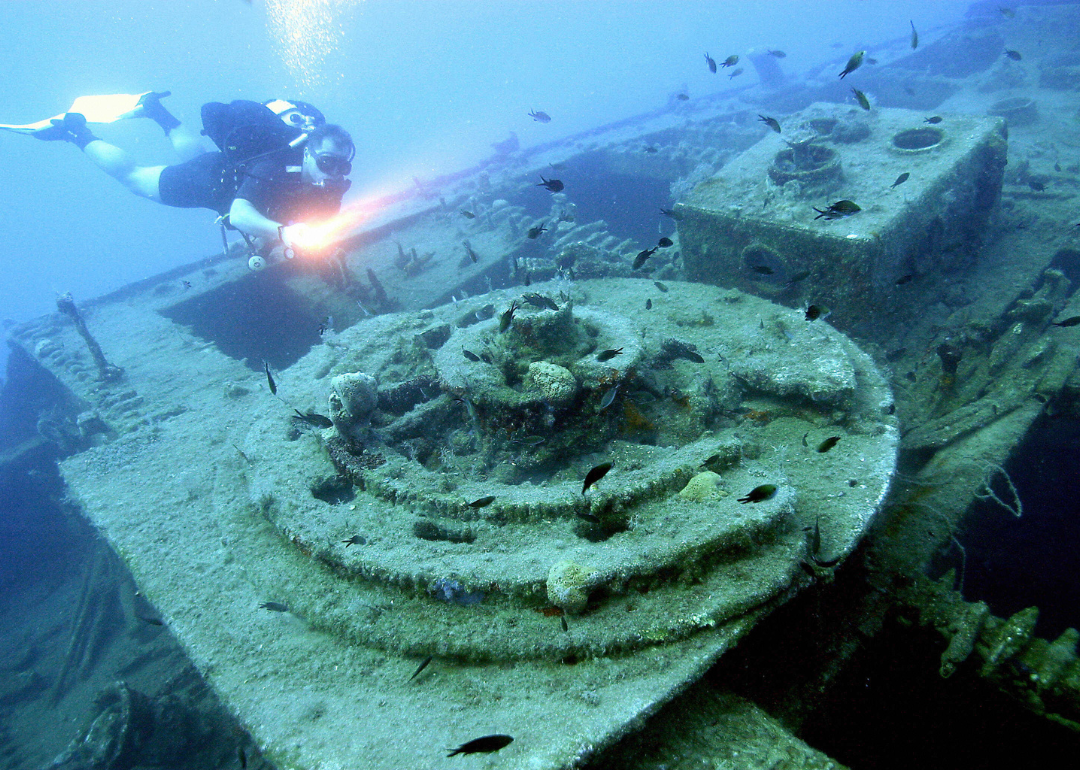
TARIK TINAZAY/AFP via Getty Images)
The Paris II, Kemer, Turkey
A diver in Turkey explores the wreckage of a WWI French Navy ship.
Through the use of shore artillery fire, Captain Mustafa Ertuğrul Aker sank the Paris II in 1917 with a short, 25-minute barrage off the shore of Kemer, then rescued the majority of the ship’s crew and treated them with hospitality. Previously used as a fishing boat and coming in at 180 feet long, the Paris II was repurposed as a patrol boat for the war effort and is said to appear to float in its underwater resting place. Live ammunition remains on its submerged deck.
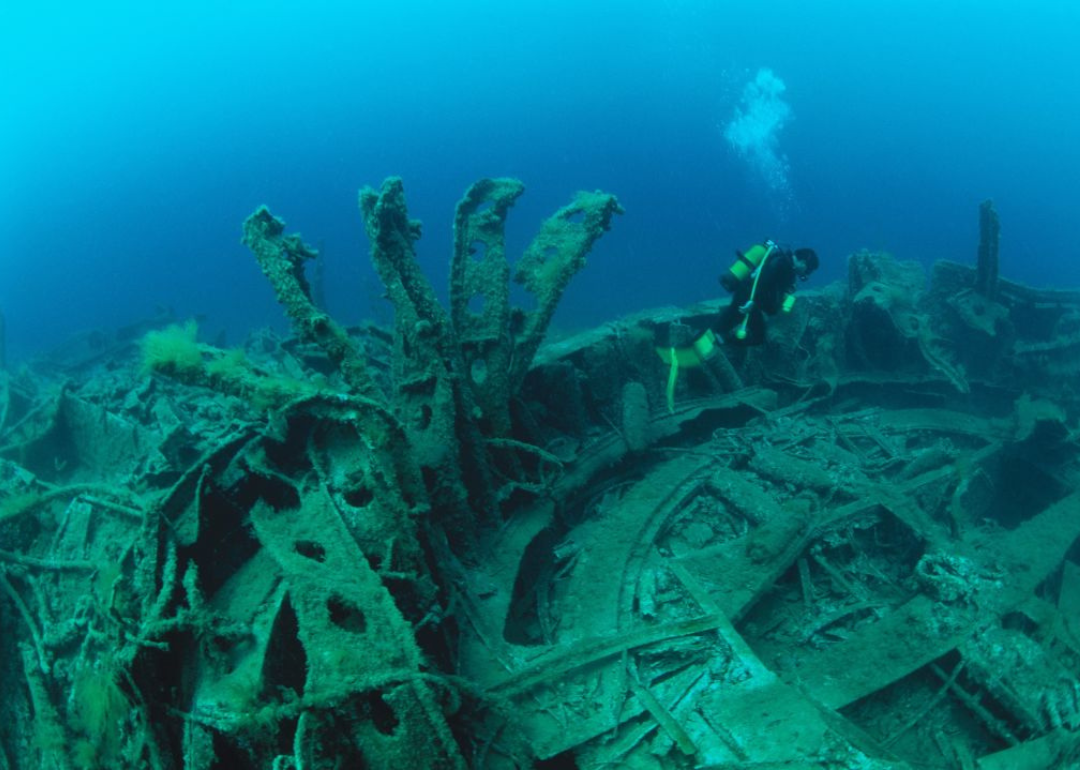
Tahsin Ceylan/Anadolu Agency/Getty Images
HMS Majestic, Canakkale, Turkey
A diver explores the underwater wreckage of the Majestic Flagship
A Majestic-class battleship that became increasingly obsolete over the course of the First World War, the HMS Majestic was sunk by a German U-boat during the Battle of Gallipoli, a failed British offensive against the Ottoman Empire in 1915. Sinking in just seven minutes, and at 412 feet long, the HMS Majestic is mainly intact and makes for spectacular diving.
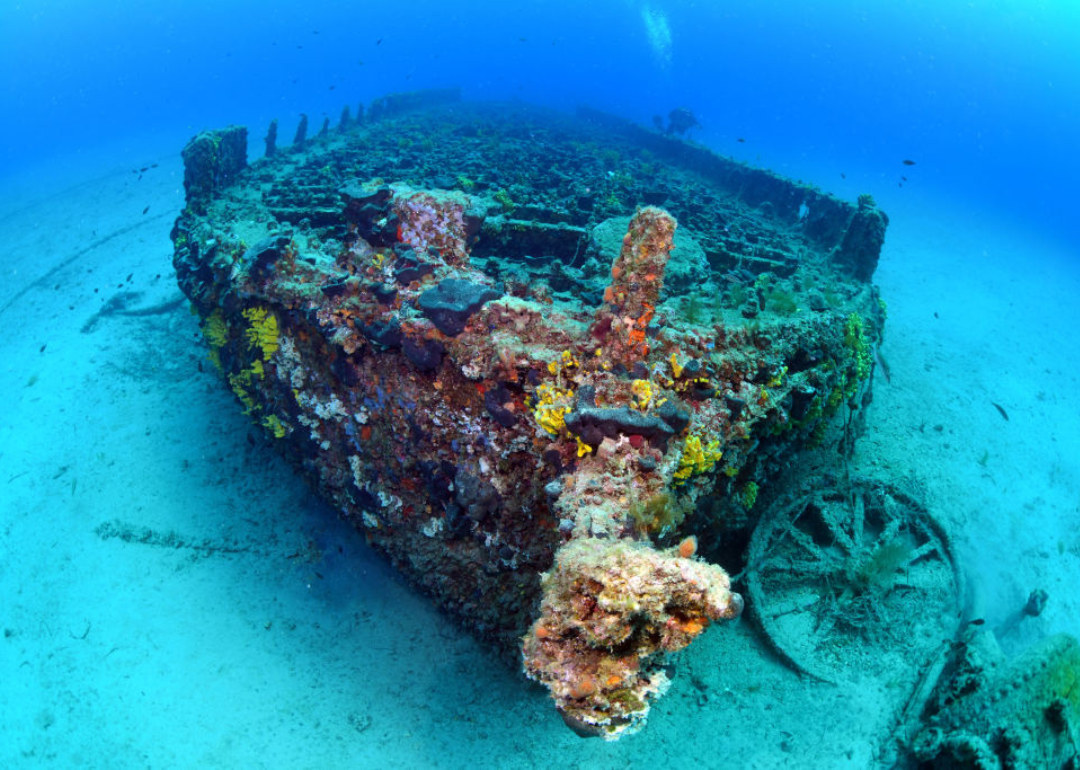
Tahsin Ceylan/Anadolu Agency via Getty Images
Sunken barges, Canakkale, Turkey
A barge near the wreck of the HMS Majestic.
Sinking in the same assault that capsized the HMS Majestic, these two non-motorized barges were used for transportation by the British during WWI. Located at a depth of only 65 feet, the blue tones of the surrounding water contrast with the heavily barnacled and well-preserved hulls of the sunken vessels.
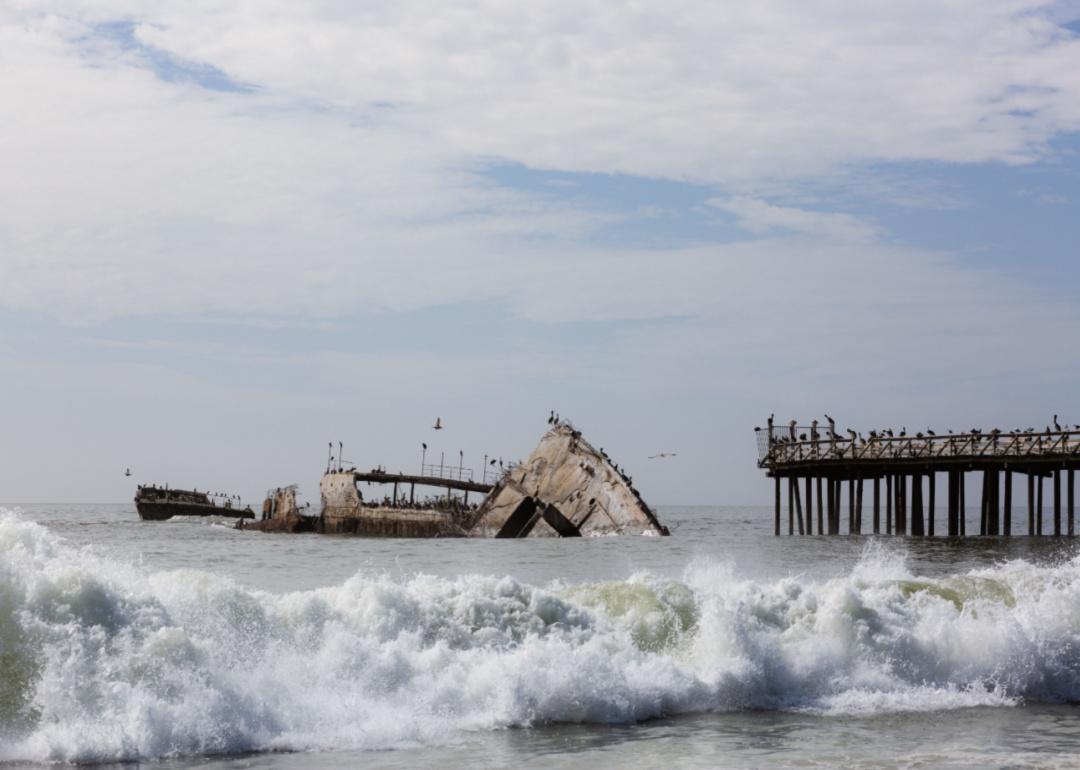
Logan Bush // Shutterstock
SS Palo Alto, Palo Alto, California
Birds circle the SS Palo Alto, a concrete ship built as a tanker at the end of World War I.
Built as an oil tanker intended for use in WWI, the war ended before the SS Palo Alto saw service, and the ship was later sold to Seacliff Amusement Corp. of Nevada, which towed the ship to Seacliff State Beach in 1929. Used as a party boat outfitted with casinos, dance halls, and more until the company went under during the Great Depression, the ship was left to rust at the end of a pier, where it now remains for birds to occupy and onlookers to photograph.
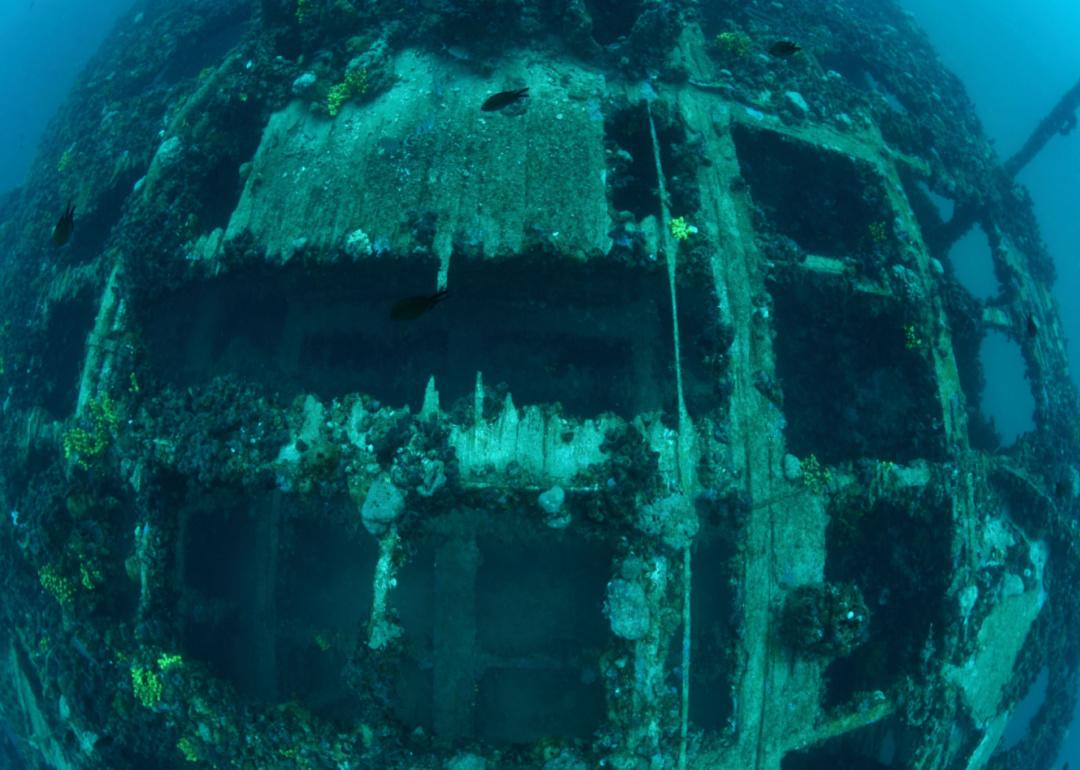
aquapix // Shutterstock
Baron Gautsch, Mediterranean Sea
Shipwreck of the Baron Gautsch underwater in the Mediterranean Sea
The Baron Gautsch was an Austrian passenger ship primarily transporting families and crew members when it sailed straight through an Austro-Hungarian minefield in 1914 and sank, resulting in over 127 deaths. Located off the coast of Croatia, the Baron Gautsch shipwreck is a popular destination for divers and allows exploration of the interior of the wreckage.
You may also like: 50 best American war movies

aquapix // Shutterstock
Giuseppe Dezza, Rovinj, Croatia
Shipwreck of the Torpedo boat Giuseppe Dezza and scuba divers underwater in the Mediterranean Sea.
Refitted as an Italian gunboat during WWII, the Giuseppe Dezza was split in half by a torpedo attack in 1945. The broken segments lie off the coast of Croatia, the front half of which features an anti-aircraft gun, with the wreckage overall occupied by a variety of coral life including lobsters and conger eels.
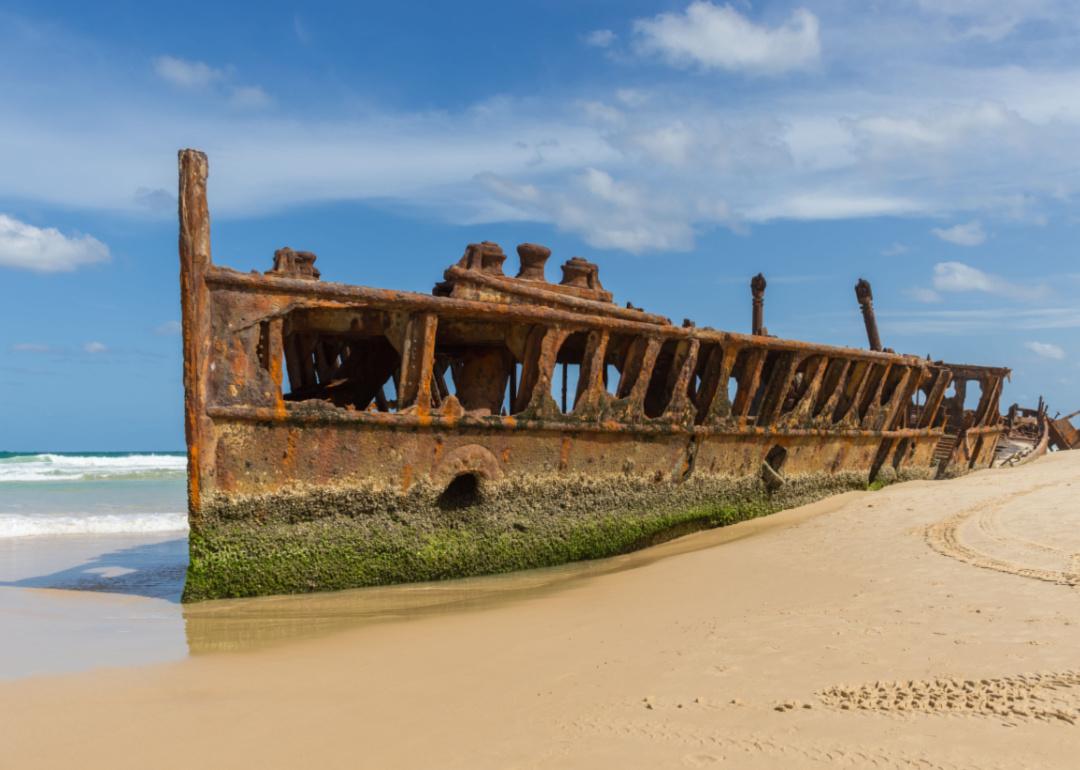
f o g a a s // Shutterstock
Maheno shipwreck, Fraser Island, Australia
Maheno shipwreck on the beach at Fraser Island, Australia
The most famous of 23 wrecks recorded on Fraser Island, the Maheno was an ocean liner bound for scrapping in Japan when it was caught in a cyclone and ran aground in 1935. The salinity of the environment has deteriorated its hull significantly, giving the Maheno a haunted, foreboding look.
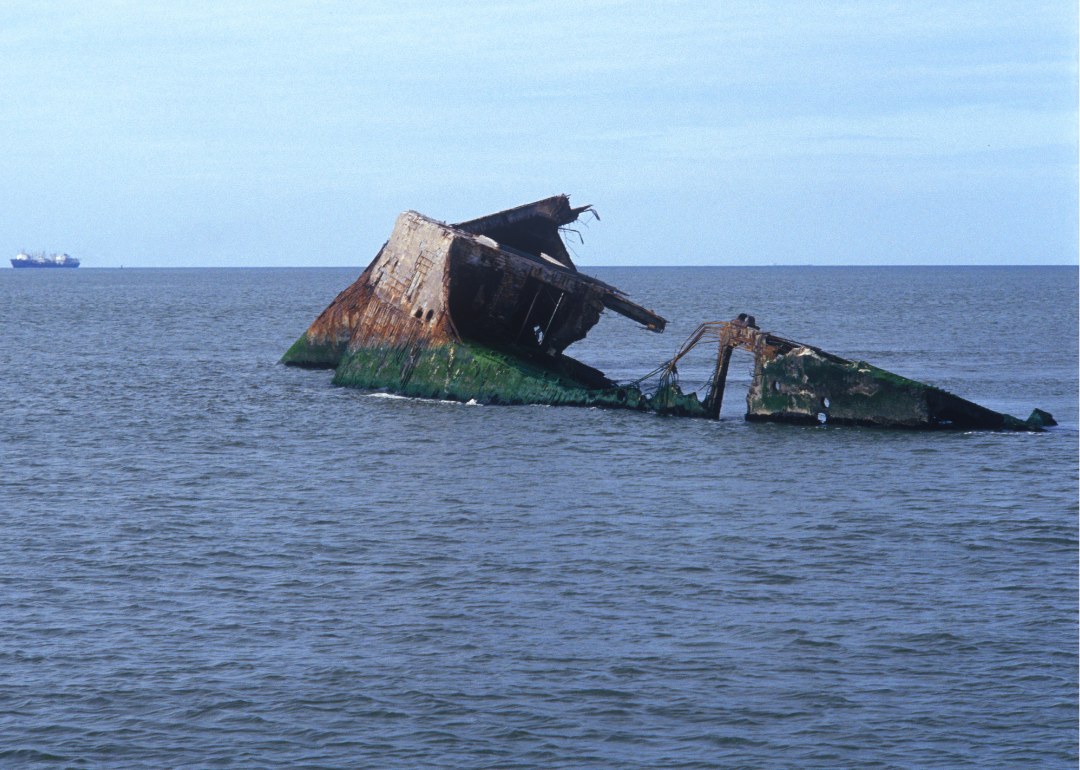
Joe Sohm/Visions of America/Universal Images Group via Getty Images
SS Atlantus, Cape May, New Jersey
The remains of the S.S. Atlantus in the water off the coast of Cape May.
One of a series of 12 concrete ships commissioned for use in WWI that never saw service, the SS Atlantus was bound for use as a ferry dock in New Jersey when a storm broke her free of her moorings. The Atlantus ran aground 150 feet off the coast of Sunset Beach, and though attempts were made to free the vessel, none were successful and its deteriorated carcass juts above the surf to this day for beachgoers to observe.
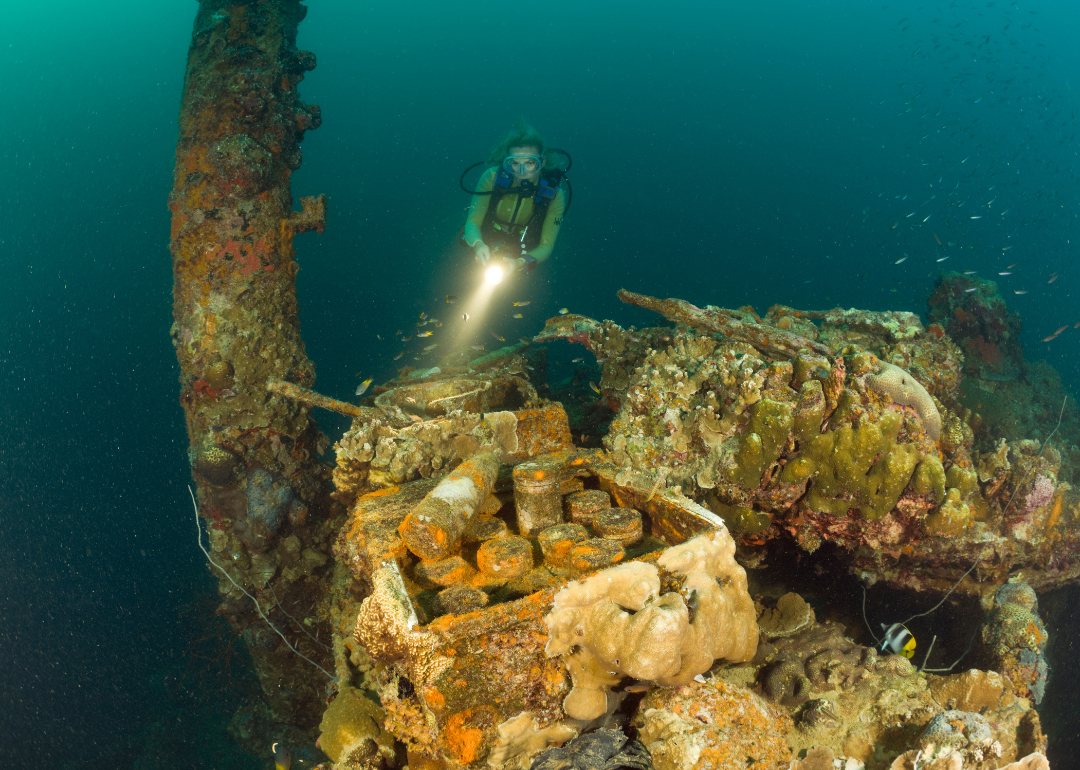
Reinhard Dirscherl/ullstein bild via Getty Images
Helmet Wreck, Palau, Micronesia
A diver exploring the sunken wreckage of a Japanese warship.
Discovered by happenstance in the 1980s by divers off the coast of Palau, this ship’s official designation has gone unrecorded, though its wreckage was part of Operation Desecration I, which took place in 1944 during the bloody Pacific War. Called the helmet wreck for a signature rack of fused helmets, the site features much of the equipment used by the Japanese soldiers aboard, including—up until 2013-2014, at least—crates of live munitions.
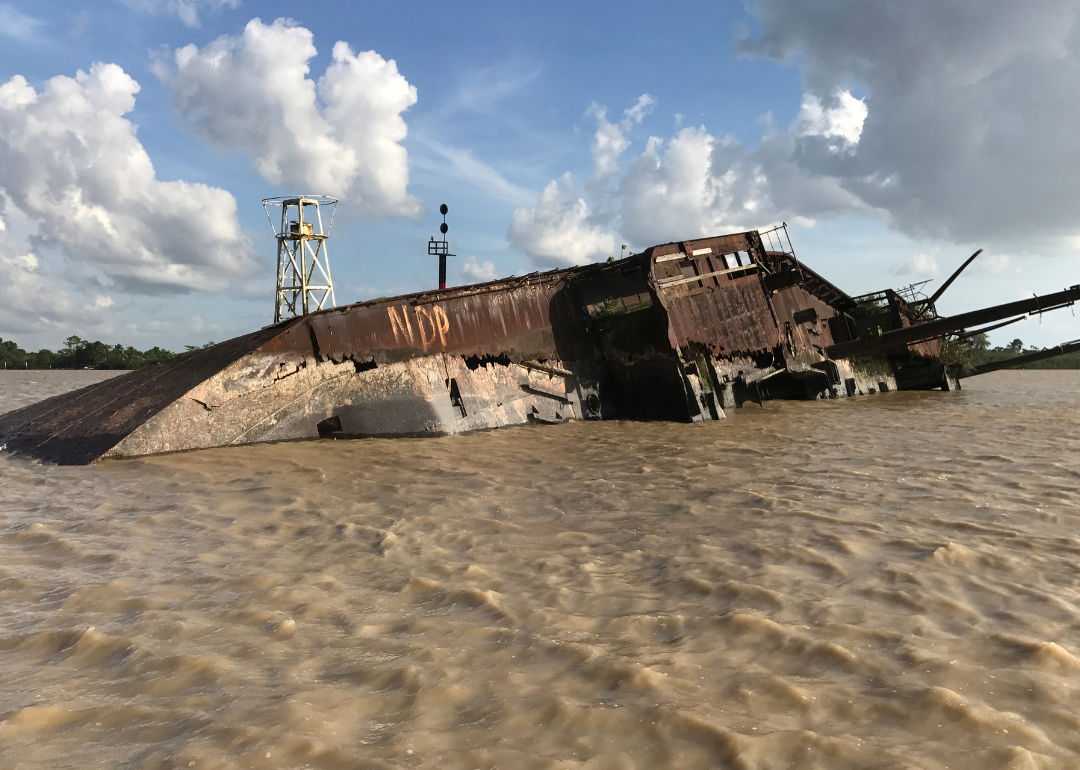
Georg Ismar/picture alliance via Getty Images
Goslar cargo ship, Paramaribo, Suriname
The wreckage of the German cargo ship ‘Goslar’, outside Paramaribo, Suriname
The SS Goslar, a steamboat, was at port in Suriname when Germany invaded the Netherlands in 1940, causing the country (then a colony of the Netherlands) to begin to intern German men living in the immediate vicinity. Before capture, the German crew of the Goslar scuttled the ship, capsizing it portside where it remains to this day, half-visible above the waves.
You may also like: 50 best WWII movies of all time

Ethan Miller/Getty Images
Higgins landing craft, Lake Mead, Nevada
A sunken World War II-Era landing craft is revealed near the Lake Mead Marina as the waterline lowers.
Of the many objects revealed during the drought-induced decline of Lake Mead, a WWII-era Higgins landing craft—of the sort used during D-Day—was one of the more striking. Sold by the military as Army surplus, the boat in Lake Mead was for a number of years used to survey the Colorado River, before being scuttled in the lake to anchor a breakwater.
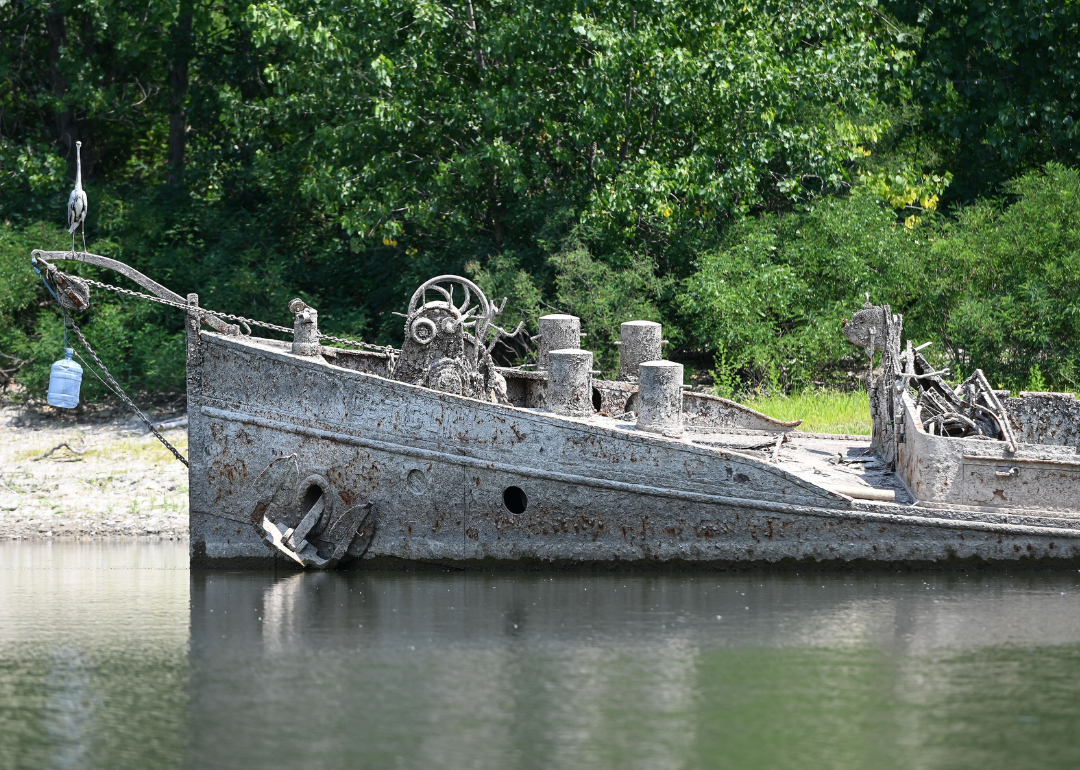
PIERO CRUCIATTI/AFP via Getty Images
Zibello barge, Gualtieri, Italy
A heron stands on a large 55-meter barge that was sunk by WWII American bombing
When record-breaking drought in 2022 caused Italy’s largest river, the Po, to recede, the full wreckage of a WWII-era barge was revealed for the first time. Used to transport wood, the ship sank during an American bombardment in 1943. Leading up to the drought, the hull of the ship was only occasionally visible to passersby.

Reinhard Dirscherl/ullstein bild via Getty Images
HIJMS Nagato Battleship, Marshall Islands
A diver circles the propeller of HIJMS Nagato Battleship
Built in 1920 and used throughout WWII as a particularly resilient battleship, the Nagato met its watery grave in the aftermath of Japan’s surrender, where it was used as a part of the Marshall Islands atomic tests conducted by the U.S. in 1946. After surviving elements of the first test blast, during the second (called Test Baker) the Nagato was positioned only about a half-mile from ground zero and capsized upside down five days after the explosion. A massive 708 feet in length, this shipwreck is vast enough to explore for multiple days and is one of the more popular dives in Bikini Atoll.

MPI/Getty Images
USS Arizona, Pearl Harbor, Hawaii
An aerial view of the USS Arizona National Memorial, which spans the sunken hull of the battleship in Pearl Harbor
Capsized during the 1941 attack at Pearl Harbor, the sinking of the USS Arizona resulted in the deaths of 1,177 crew members. Spanning the width of the battleship’s wreckage is the USS Arizona Memorial, an exhibit that is part of the Pearl Harbor National Memorial, operated by the National Parks Service since 1980.
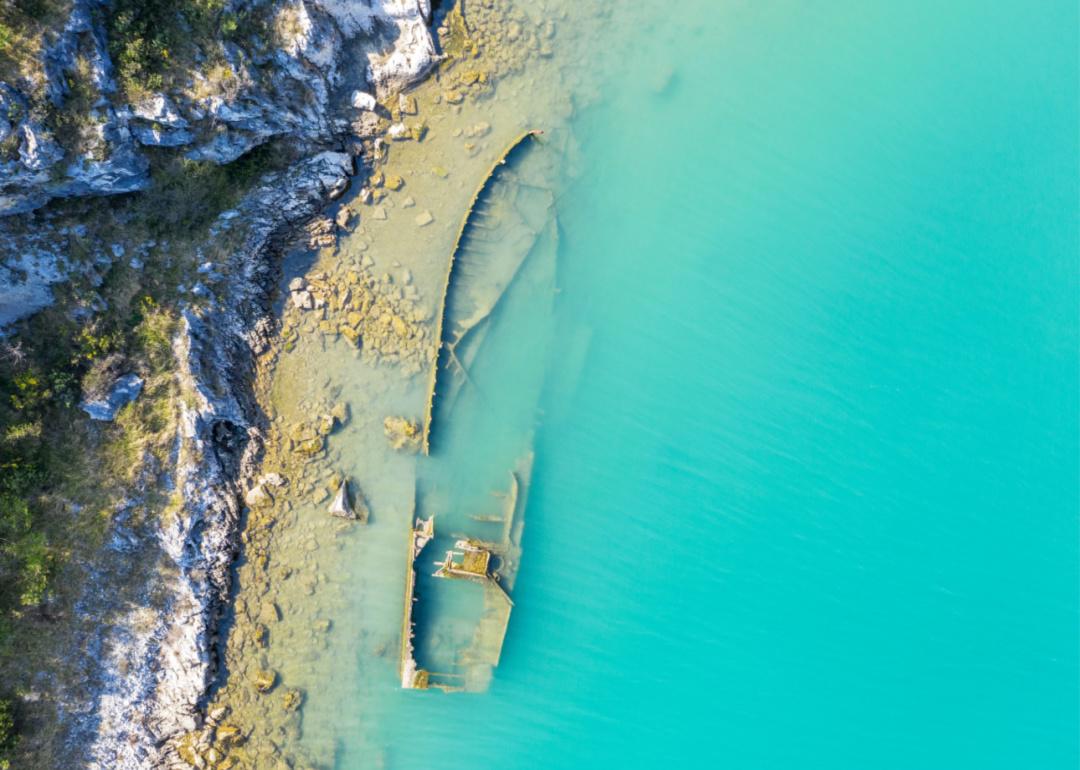
burnel1 // Shutterstock
German Ship Fritz, Istria, Croatia
Aerial view of the sunken WWII German ship Fritz off the coast of Istria, Croatia.
Nestled into the blue waters of Croatia’s Rasa Bay, the wreckage of this WWII-era German vessel is easily accessible from the surrounding region. Little is known about the history or purpose of this vessel, but it rests in such shallow water that it is readily visible from the adjacent beach, the ribs of its construction rising from the surface like a row of prehistoric teeth.
You may also like: A timeline of WWII, one of the most devastating conflicts in world history

Kondratuk Aleksei
Nippo Maru Wreck, Chuuk Lagoon, Micronesia
Underwater photo of the wreck of the Japanese Nippo Maru shipwreck.
One of the many shipwrecks available to explore in Chuuk Lagoon, the Nippo Maru was sunk as a result of the U.S.-led Operation Hailstone, which destroyed many Japanese ships based in the lagoon. Intact and upright, the Nippo Maru wreckage is host to a wide array of period pieces, including over 200 bottles of beer and an intact Type 95 Ha-Go Tank.
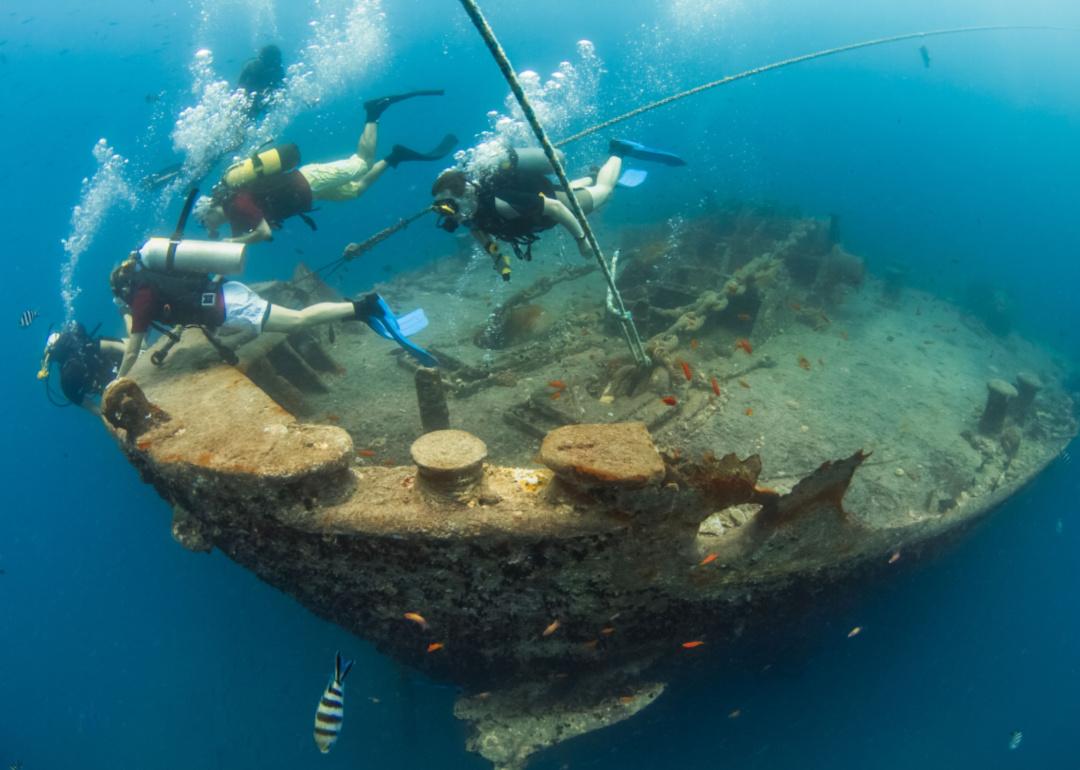
Mayumi.K.Photography // Shutterstock
SS Thistlegorm, Sharm El Sheikh, Egypt
Scuba divers in the bow of the Thistlegorm shipwreck in the Red Sea.
One of the most popular dives in the world owing to its well-preserved WWII-era artifacts, the Thistlegorm sank after German bombing split the ship in half. Having navigated around Africa to avoid Axis activity in the Mediterranean, the Thistlegorm wound up in the Red Sea as it had been transporting much-needed supplies to Allied troops in North Africa.
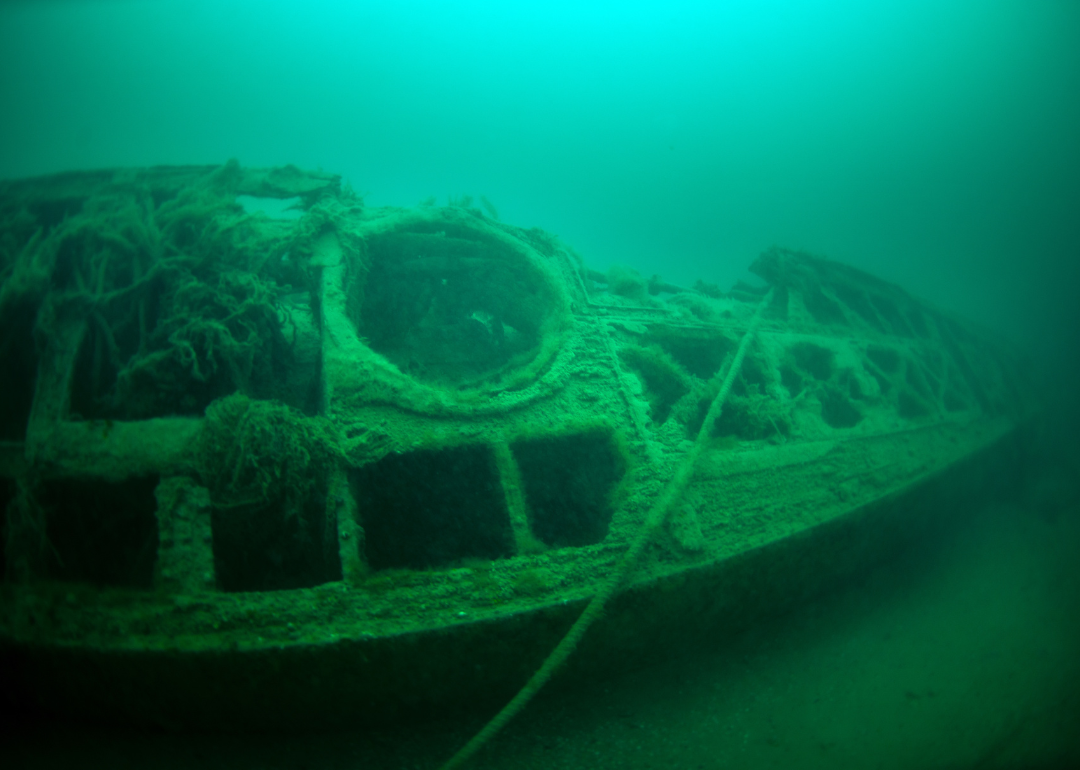
Tahsin Ceylan/Anadolu Agency via Getty Images
Sunken German submarines, Kocaeli, Turkey
Underwater view of a sunken U-23 German submarine.
As WWII drew to a close, a contingent of six German U-boats stranded near Turkey were scuttled by their captains in 1944 to avoid falling into enemy hands. Of those six—known collectively as “Hitler’s Lost Fleet”—three were subsequently destroyed by Soviet forces. The remaining three have been steadily rediscovered over time, with U-23 depicted above discovered in 2019, U-20 discovered in 1994, and U-19 as yet unfound.
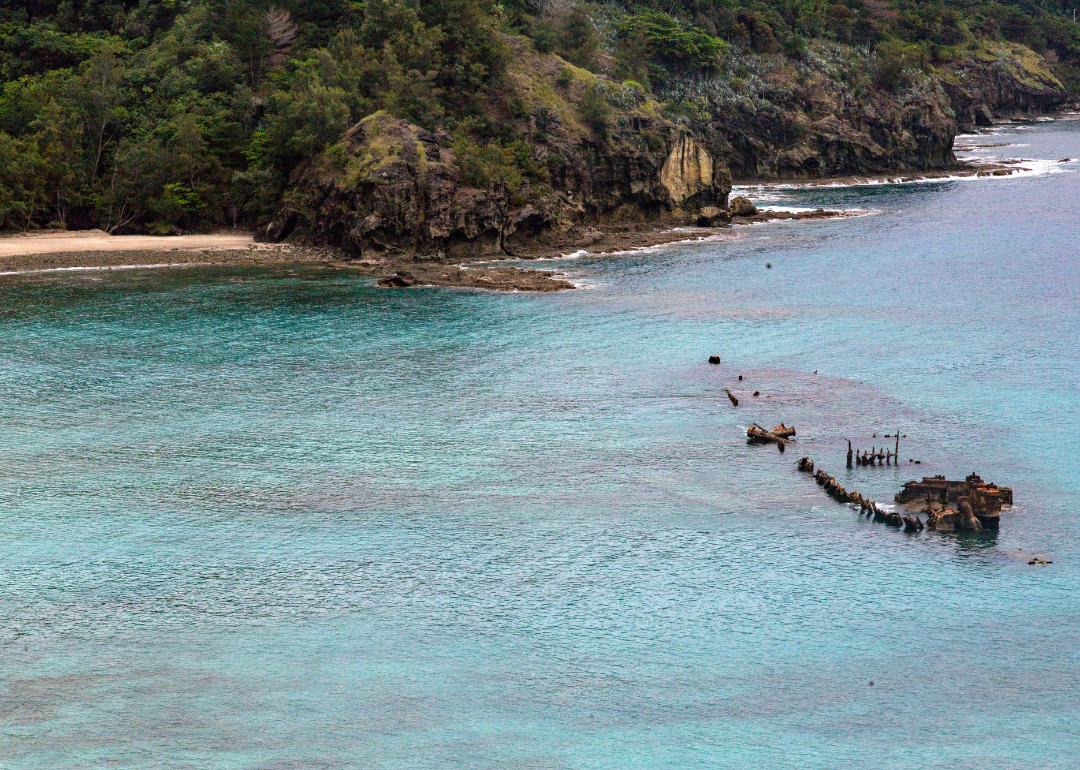
John S Lander/LightRocket via Getty Images
Hinko Maru warship, Sakaiura Beach, Japan
The partially submerged wreck of the Hinko-maru off of Sakaiura Beach.
Among the white sand and calm waters of Sakaiura Beach are the rusted ruins of the Hinko Maru, a Japanese transport ship sunk by U.S. forces in 1944. A six-minute bus ride from town, the wreckage is able to be explored via snorkeling, making it uniquely accessible.
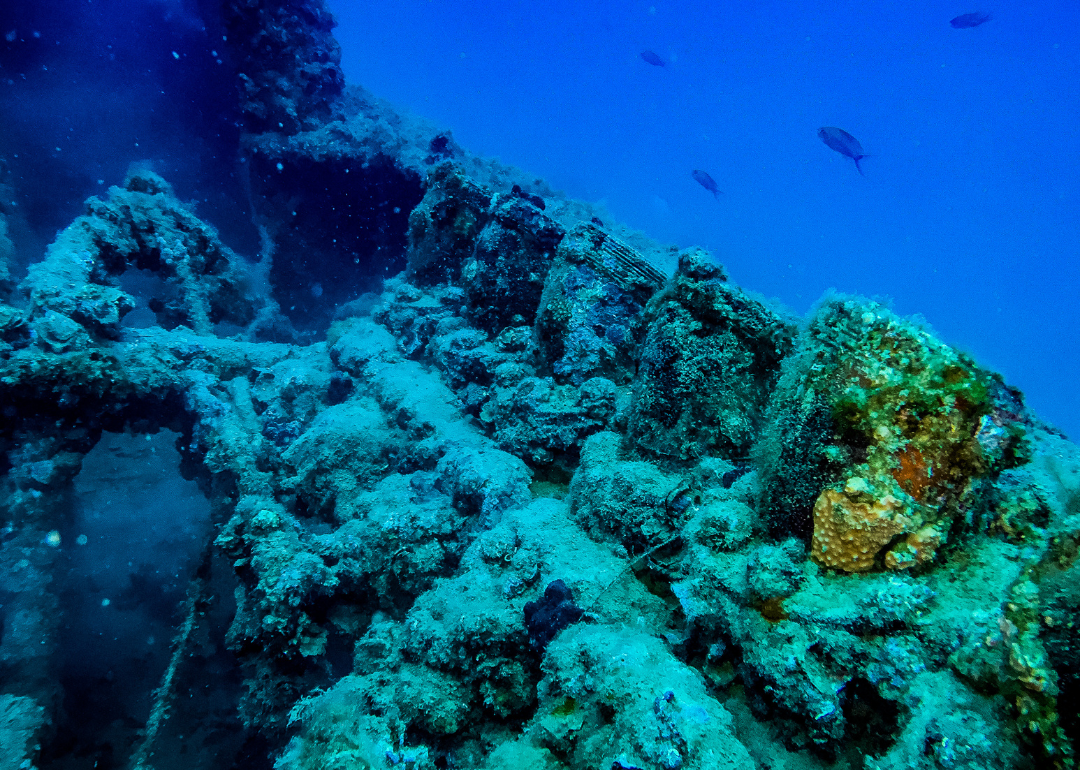
Alessandro Rota // Getty Images
Cinque Terre shipwreck, Bonassola, Italy
Underwater view of a shipwreck outside Bonassola Liguria Italy.
Resting near the Cinque Terre Marine Park, the SS Bolzaneto was sunk by British torpedoes in 1943, splitting the transport vessel in half. Outfitted with single-barreled cannons and home to shoals of damselfish and silversides, divers can explore the Bolzaneto inside and out.
You may also like: Most expensive military weapons and programs



